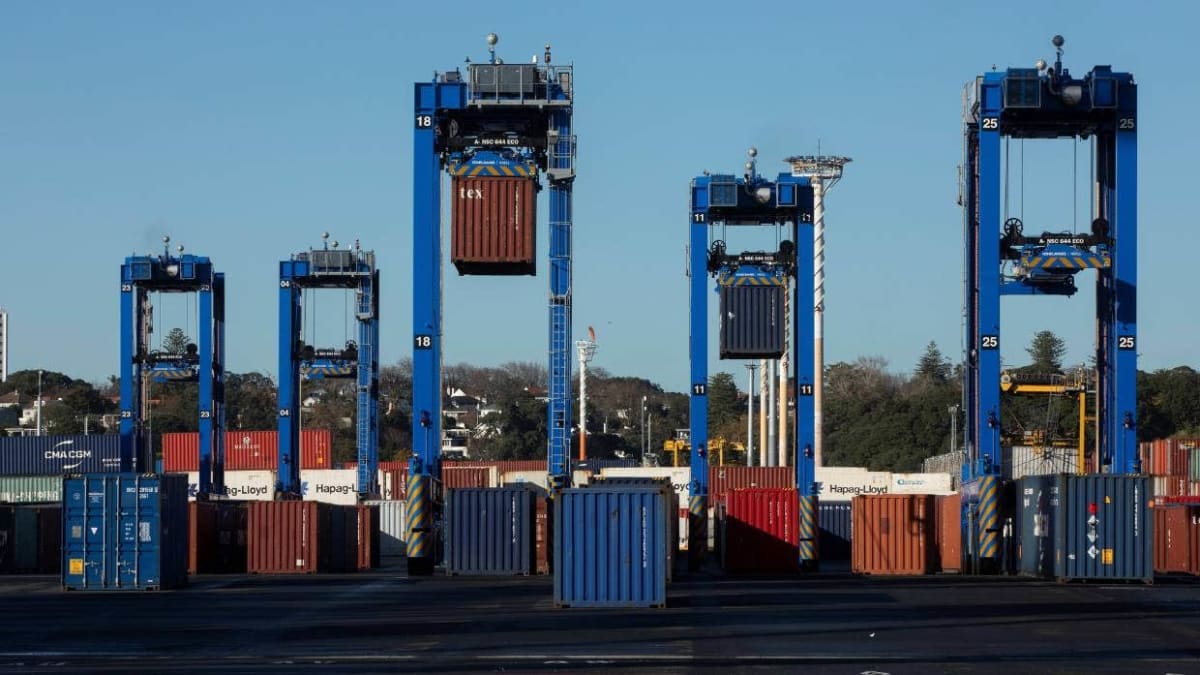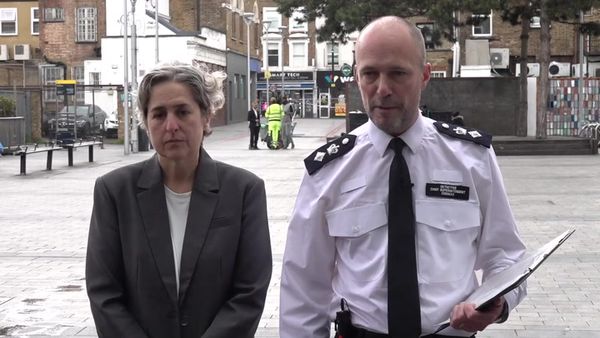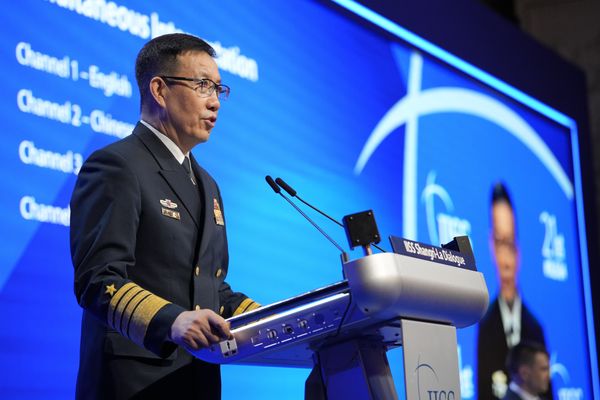
Rejecting an independent reviewer's accusation that he created a 'septic culture', Tony Gibson says the mayor and new board have made a massive mistake in shutting down a project to automate Auckland port.
Exclusive: Tony Gibson recalls sitting in Singapore, negotiating a multimillion dollar contract with a customer, when news came through that Phil Goff had publicly discussed moving the port out of central Auckland. "And the customer said, well, why would I sign a contract with you when this is going on?"
In an interview with Newsroom, the former Ports of Auckland chief executive has spoken out for the first time since he was forced out of his job last year, blaming “personal attacks”.
"I raised it with Goff," he says. "I said, you know what you've done, you're diminishing our value. And I think sadly, because of his lack of commercial acumen, he never understood what I meant."
Now, as mayoral candidates Wayne Brown and Efeso Collins debate the partial sale of the troubled port, Gibson and the port's former chair Liz Coutts have finally decided to speak publicly. They are responding to trenchant criticism in an independent review of the governance of the port's big automation project, and its $65 million write-off.
READ MORE:
► Former Ports chair says automation review was ‘fundamentally flawed’
► Furious mayor Phil Goff on a future without Port-omation
Reviewer Mark Binns' summary, published last week, found governance was lacking around key contractual milestones and the decision to change the acceptance testing was "incomprehensible", when there was already material disquiet about the performance of the technology supplier.
"Given the transformational nature of the project and the extremely significant consequences of failure, it was incumbent on the board to fully understand the risks that the Company was assuming, to ensure that the senior management team was engaged, that the organisation was capable of the change required, and that the project team was appropriately resourced, with employees with expert knowledge in key areas," he found.
"On balance, it is apparent that the board did not take the steps necessary to ensure that this was the case."
Coutts has brought in lawyers to challenge the "predetermined" findings, and now the company's former leadership is turning the fire on Binns, on the new board and chief executive, on the Maritime Union – and especially on outgoing Auckland mayor Phil Goff.
When Gibson quit in May 2021, the council-owned company's flagship project to automate container movements had faced delay after delay, its revenues had fallen, container ships had been left queued in the Hauraki Gulf, and tragic workplace incidents had killed three men.
In early 2024, Gibson is to appear in court on two charges in connection with the death of stevedore Pala'amo (Amo) Kalati in 2020. The father-of-seven died on a ship at the Fergusson Container Terminal, when a container was dropped on him during a lifting operation on night shift. The unprecedented charges carry up to $400,000 in fines, for exposing an individual to risk of death or serious injury.
"I'm very passionate about health and safety ... I've also got 11 or 12 people between the lasher and myself. So you've got to have the trust and confidence that along the chain, everybody's doing their good work around health and safety." – Tony Gibson, ex-Ports chief executive
But first, he agreed to an interview with Newsroom.
Painfully transparent? Or plain reckless? Supporters and critics will draw their own conclusions from his decision to sit down for an interview, without any lawyer or PR advisor at his side, while he is facing charges.
The background
It was October 2012 that ports software and technology contractor TBA presented a port development plan for consideration, providing options for increasing capacity by including automatic stacking cranes, rubber-tyred gantry cranes and automated straddles.
The Ports of Auckland had a new chief executive, Tony Gibson. He and the port were interested. He'd spent his first 12 months in the role battling the Maritime Union in an industrial dispute that cost the port the business of big players like Fonterra and Maersk, costs striking stevedores thousands in lost pay, and saw kids' Christmas presents stuck on the wharves. Everyone was hurting – and the port's leadership was hungry for new solutions that didn't expose them to the union.
Over the coming months and years, the ports company and TBA developed the plan further. TBA argued the strategy could increase the Auckland downtown port’s capacity from a million to two million 20-foot containers (TEUs in the industry jargon) every year.
With no public or political appetite for reclaiming more of the city’s beautiful Waitematā Harbour for docks, the pressure grew to stack containers higher, and move ships in and out faster.
Gibson’s team visited TBA and Konecranes in Europe, and brought back an experienced ports automation operator, Ross Clarke. He had previously run Auckland’s Bledisloe Container Terminal before taking on big ports in Singapore and Europe for global operator APM Terminals. soon after they appointed Bob Post, who had overseen five other automation projects around the world, as the ports' technical advisor.
The Port Future Study confirmed the company would give up any prospect of land reclamation.

So they confirmed with the council’s holding company Auckland Council Investments Ltd that, instead, they would implement tall, automated “one-over-three” straddles that could stack containers four high. The endeavour would be called Project Darwin. It would be transformational, it would buy a fight with the Maritime Union – and it wouldn't come cheap. The new 70-tonne straddle carriers would hurtle around at up to 22km/h, without anyone at the controls.
There were, at the time, essentially three main options: no automation, partial automation of just the straddles, or full automation of both the straddles and the cranes. At the time, the company considered that full automation was not yet sufficiently proven, globally. There were far more ports successfully running just automated straddles.
TBA was asked to do some costings. In September 2015, a pre-study vendor selection paper recommended the company work with TBA’s sister company Terex (both now owned by Konecranes) as its price was substantially lower than Kalmar, and it was their incumbent equipment supplier.
But it was there that the strings of delays began.
One delay after another
At the north end of Fergusson Container Terminal, Ports of Auckland prepared to shape a new future. There, selected ships would berth and have their containers unloaded by traditional cranes, operated by workers sitting up high. But then the containers would be picked up by tall blue automated straddles, able to stack the containers four high.
The first delay hit immediately. An Auckland unitary plan ruling meant the company might have to apply for resource consent for each of its cranes to excess height restrictions. Ports of Auckland had to delay the importation of three big $20m Chinese cranes linked with the automation project.
The supplier was three months late delivering the cranes, and there was malware detected that had to be remedied.
So the board decided to move the capital expenditure budget from 2017 to 2019.
Then, in the early hours of August 27, 2018, Laboom Dyer's straddle crane tipped over and killed him. The 23-year-old left behind his former partner Natesha and their son Noah.
In a subsequent WorkSafe prosecutions, court documents show the straddle cranes that Dyer was driving were fitted with an alarm that sounds when the vehicle is in danger of tipping.
The port operated a bonus system that rewarded drivers who completed the most container movements but did not take into account tip alarm activations. Dyer regularly received the bonus but also had one of the higher tip alarm rates.
It is human factors like these that provide an argument for automation, according to Gibson. He says the evidence from around the world shows automated straddles are safer; the Maritime Union disagrees.
Dyer's death caused parts of the port's operations to be shut down while it was under investigation.
Gibson says: "That, as you may recall, caused major congestion, because we were closed down for a while and it interfered with the peak season, which was September-October-November. And we were supposed to go live the following year."
Undeterred, Gibson showed off the new blue straddles to councillors, at a workshop in March 2019. The auto-straddles would be run by computers, but closely watched by operators in a nearby control room, atop the ports office building.
The point was made that Dyer had died in a manually-operated yellow straddle, on a different terminal from where the company was getting the automated straddles trial underway. Yet the accident caused delays to the automation project, too.
Goff and the councillors were shown the control room, and the test area, where the straddles were being trialled. "The mayor and councillors were encouraged to regularly visit and see progress around automation," Gibson says.
But they didn't. Dyer's was one of three deaths that prompted Auckland Council to commission an investigation into the port’s health and safety.
"I used to walk along here on a Sunday afternoon and stand at the fence and watch the project." – Liz Coutts, former Ports chair
In 2019, as peak season demands heightened, the decision was made to defer the partial go-live on the Northern Berth from the end of 2019 to March 2020. "We agreed that with the board, we agreed that with our customers, and we were about to start, about to press the button."
Then, as Gibson says, along came Covid – the third big delay. "And basically we couldn't get the people into the country from Holland to actually support the project," he says. "So we ultimately went live during a Covid period, with people dialling in through MS Teams."
In November 2020, one of the large automated straddles toppled over a retaining wall at the Fergusson Wharf terminal. Then in May 2021, another reportedly lost control and smacked one container into a stack of others.
"Effectively, the blue strads or the auto-strads have a geofence. You can't move outside that. The incident that happened, it knocked over a container on one of the bays in the terminal," he says.
"Now, that was a manual mistake. Because what happened was, you've got a terminal operating system. And you've got what you call TEAMS [not to be confused with MS Teams] which was the auto system that ran the strads.
"Obviously, there's a significant interface between the two. Someone rebooted reboot the system, but they forgot to reboot the terminal system at the same time. So the two were out of sync, okay? But no one was injured in the process."
"They tried to make it work, but there were so many manual interventions. And the manual interventions on the last ship were 5000." – Tony Gibson, ex-Ports CEO
According to Reseller News, the company posted a statement on its website (subsequently deleted) after that incident: "At no stage were any people at risk thanks to the geofence safety system in the automated terminal, however, we believe that in different circumstances there could be a safety risk. While this appears to be a very small possibility, we are not prepared to continue automated operations until that risk has been fully investigated and any necessary safety controls put in place."
Was that the final straw? Probably that point has already passed in the preceding days. Liz Coutts had already retired as chair and director when her 10-year term ended in January 2021. Gibson was under enormous public and political pressure and he too had made the decision to quit, effective June 2021.
The automation trial continued, but without its sponsors its struggled for cut-through. By that point, the automated straddles had unloaded and loaded 120 ships on the Northern Berth and, according to Gibson, achieved some good productivity rates.
But he has some insight into what happened in the final months after his departure. "They tried to make it work, but there were so many manual interventions," he says. "And the manual interventions on the last ship were 5000."
What that indicates is that the Ports of Auckland and its workers no longer had confidence in the automated system. They were second-guessing it, constantly. Whenever they doubted an action, a human operator would intervene.

"You look at a move in the terminal and you say, that doesn't look right. So you change it. But you're not capable of thinking 100, 200, 300 moves ahead. There are algorithms there that are looking at the manifest and the bay plans. It says, well, it is logical. It's around process and training, or lack thereof. The same software at a terminal in Israel, guess how many manual interventions on average on a shift? Five."
In June 2022, after two internal reviews, the new board of Ports of Auckland made the decision to terminate the automation project, and write off the $65 million spent on its software and other costs. The big blue automated straddle carriers would be retrofitted for manual operation.
It is a decision that will be debated for years to come. Critics will argue the automation system flawed; supporters will argue it was human operator failure. The implications are enormous – because Ports of Auckland's biggest competitors and collaborators (like Melbourne, Sydney and Brisbane) are all now automated, or in the case of Tauranga, have embarked on that path.
The Ports of Auckland is not automated, has no project to become automated, and its new board and executive have no apparent plan to get there. Little wonder, then, that the new board commissioned an independent review into the decision-making that went into the automation project.
The review process
Gibson raises several key objections about how the Binns governance review was conducted.
He says Binns didn't interview the software vendor TBA, whose systems have operated effectively at a major port in Israel. "I think it's poor form to criticise one of the best technology companies in the world, particularly when they weren't interviewed as part of the process."
And, he says, Binns disregarded the arguments of former directors and project leadership, despite interviewing them.
Gibson was interviewed. He says Binns accused him of overseeing a "septic culture" at Ports of Auckland.
That's an allegation Gibson rejects, and he pulls out the findings of a December 2019 staff survey. Seventy-seven percent of the workforce agree that they feel informed about what's happening at the port, he notes. Sixty-two percent understand what the port strategic goals are. Eighty-three percent are proud to work for the port. And sixty-eight percent feel that they're either informed or very well informed about automation.
He points to innovative projects like their electric tug, and their hydrogen production facility. "For me, we would have never achieved the innovative things that we were doing with a septic culture. It had to be a positive culture."
The findings
Most of all, Gibson disputes Binns' findings, encapsulated in a two-and-a-half page PDF. There's some dispute about whether this is the full report – at the top, Binns describes it as a summary. But Phil Goff and the new Ports of Auckland chair Jan Dawson insist that's all there is, that's all they've seen, and those 18 paragraphs provide all the evidence they need.
Gibson is scathing. Point by point, he seeks to rebut the findings.
Binns says the process by which the port's existing supplier Konecranes was chosen to deliver the partial automation was "not sufficiently well structured", lacking rigorous analysis of the risks and benefits.
He says the business case was inadequate, the project team was dominated by contractors without sufficient in-house expertise, the company did not obtain software performance guarantees, and there was insufficient detailed management reporting to the board.
Wrong, wrong, wrong, retorts Gibson.
He points out that there were only two big port automation providers to choose from: existing supplier Konecranes, and Finnish company Kalmar. Kone was 15 percent cheaper he says.
And that's even before factoring in that Kalmar would have required them to spend an additional $15 million swapping over their brand new operating system to a different one, owned by a Kalmar subsidiary.
"What we said to the board, if Konecranes' performance and pre-studies are not entirely satisfactory, be prepared to invite Kalmar on-site to carry out fact-finding prior to concluding a competitive tender process for the project."
He accepts that taken in isolation the business case may not have appeared comprehensive – but he says there were several years of well-documented management and board decisions leading up to that business case. There was no need to relitigate every previous decision, to regurgitate every previous report.
"While this particular automation project failed ... it would be short-sighted to rule out the use of automated systems in the future." – Jan Dawson, new Ports chair
There were no software performance guarantees of the sort Binns expected – that's because those kind of performance guarantees simply don't exist anywhere in the global ports industry, Gibson says. The software's performance is fundamentally reliant on the operators.
And as for management briefing the board, he says the project leader Ross Clarke, who worked directly for Ports not for the automation contractors, attended and updated every board meeting.
But commissioning lots of reports, and reading them and discussing them at board meetings, isn't the same as robust oversight – is it?
Gibson acknowledges that. "The board would ask questions. The board was very engaged in terms of what the system could or could not do. Several times they visited the control room and the test area. So from from my perspective, the board was deeply engaged."
So what went wrong?
This is where Tony Gibson's lawyer might wish he had been in the room for the interview. Because Gibson concedes failings in the health and safety culture at the Ports of Auckland, that contributed to people dying, and enormous delays and disruptions to the port's operations.
School teacher Leslie Gelberger, 45, was struck by a boat while swimming off Narrow Neck Beach in April 2018; Ports of Auckland and the captain of its pilot boat were fined $424,000 for speeding.
Laboom Dyer, a 23-year-old father of one, suffered critical injuries after the straddle carrier he was driving tipped in August 2018, crushing him beneath it. Ports of Auckland was fined $540,000.
Lasher Amo Kalati, 31, was killed after being crushed when a container was dropped during a lifting operation in August 2020 – that prosecution is still proceeding.
Does Gibson think the deaths impacted on the ability to deliver the automation project, and undermined confidence in the company?
"There's no question about it. Something like that, there's not a day goes by that I don't think about it. I think about the images of those...." His voice trails off.
"It certainly undermines confidence. It's our health and safety culture that needs changing. I mean, how is it that you can train people, to the best of your ability, and then there are things that happen? So all I would say is that, yes, it did undermine the confidence in the organisation."

Do you acknowledge that your leadership contributed to some of those failings in the health and safety culture? "Look, I'm very passionate about health and safety. And I think the focus we had on health and safety was serious, we were doing the best to our ability.
"But you know, I've also got 11 or 12 people between the lasher and myself. So you've got to have the trust and confidence that along the chain, everybody's doing their good work around health and safety."
Gibson has pleaded "not guilty" to the WorkSafe charges. But are there any respects in which he can acknowledge failings on his part, that contributed to the injuries and fatalities – not to mention the enormous disruption to the business and community?
"No, I can't."
Political intervention
Today, Tony Gibson is a director of several private companies: ERoad, Vehicle Inspection NZ, North Tugz, Marsden Maritime Holdings and his own consultancy. He is distinctly jaded about the idea of ever working again for a publicly-owned company.
That's because, most of all, Gibson blames the Ports of Auckland ownership structure for the delays, derailing and ultimate termination of the automation project – a project that he says would have made the company globally competitive again.
He points to Phil Goff and the council's 2018 decision to remove the holding company Auckland Council Investments Ltd, and take direct ownership of Ports of Auckland Ltd.
That decision has already been criticised by the investments company's former chief executive, John Crawford – but his view was that it had the opposite outcome. He told the NZ Herald that the council's "mistaken belief" it had the expertise to govern and monitor commercial entities was a major reason why it took so long for the Ports of Auckland automation project to get "proper scrutiny".
"We didn't have to do to do anything really, it was destroying itself." – Craig Harrison, Maritime Union
But according to Gibson, the council was too involved. He says Goff had "no interest" in automation; instead he continually undermined the company by speculating about its future and criticising its culture.
Under ACIL ownership, the ports' net profit had averaged $69 million a year since 2014. The council was paid 80 percent as a dividend.
After the council took control, Gibson says those numbers declined markedly. According to the 2022 annual report, the cancellation of the automation project resulted in a net loss after tax of $10.275m. The council was paid a $14.2m dividend.
"The real thing for me is the ownership structure. We tried three times to convince the mayor that you needed to actually adopt what they call a World Bank Model. You separate the land from the operating company. So the land is still owned by the council, the shareholder, and they do a long-term lease to the operating company. But then in addition, the shareholder sells down the operating company. And then you bring in alternative shareholders like ACC, like the Super Fund, like Ngāti Whātua or like Tainui."
"Ports of Auckland went distinctly downhill after ACIL was disestablished. ACIL provided astute commercial and business acumen – something which is distinctly missing from the mayor and council," Gibson says.
"In 2019, we had an agreement from council to reduce the dividend, to fund capital projects. There comes a time when you've got to start funnelling money into investing for the future. That's despite Goff, time and time again, having reports done about moving the port, which impacts on our value – the value of Ports of Auckland – and the ability to attract long-term contracts with customers."
"If I was him, I would have championed the technology. He visited the terminal only once, during testing and implementation, despite numerous invitations from the chair and myself.
"Goff talks about leadership. For me, he's the most failed leader I've come across."
If Gibson and Goff were to run into each other in the street, Gibson says he would remain civil – but he would tell him what he thinks of the decision to end the automation project. "I would say to him, I think it's a major failing, and it lacks leadership. And what you've done is basically you've failed to secure the future of the Ports of Auckland and a good revenue stream and a good dividend stream."
READ MORE: ► Former Ports chair says automation review was ‘fundamentally flawed’ ► Furious mayor Phil Goff on a future without Port-omation







